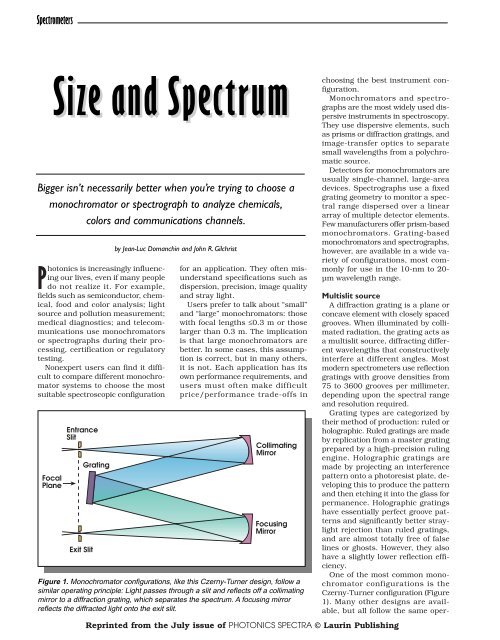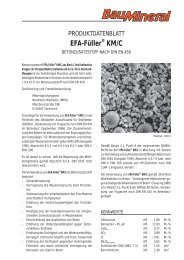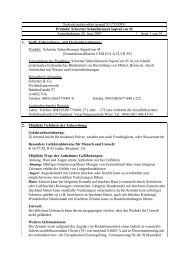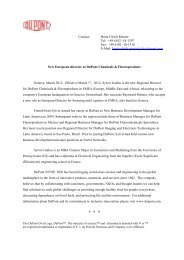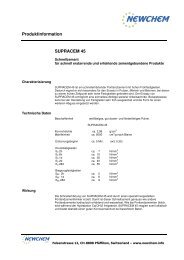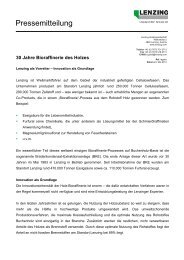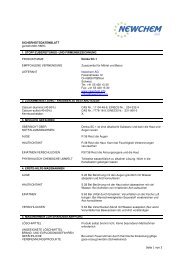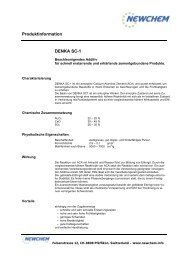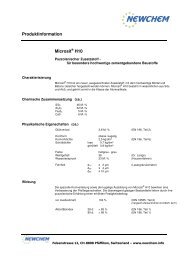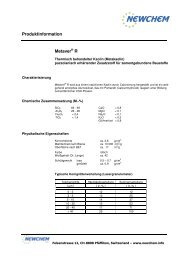Choosing a Spectrometer - Horiba
Choosing a Spectrometer - Horiba
Choosing a Spectrometer - Horiba
Create successful ePaper yourself
Turn your PDF publications into a flip-book with our unique Google optimized e-Paper software.
<strong>Spectrometer</strong>sSize e and SpectrumBigger isn’t necessarily better when you’re trying to choose amonochromator or spectrograph to analyze chemicals,colors and communications channels.Photonics is increasingly influencingour lives, even if many peopledo not realize it. For example,fields such as semiconductor, chemical,food and color analysis; lightsource and pollution measurement;medical diagnostics; and telecommunicationsuse monochromatorsor spectrographs during their processing,certification or regulatorytesting.Nonexpert users can find it difficultto compare different monochromatorsystems to choose the mostsuitable spectroscopic configurationFocalPlaneEntranceSlitExit SlitGratingby Jean-Luc Domanchin and John R. Gilchristfor an application. They often misunderstandspecifications such asdispersion, precision, image qualityand stray light.Users prefer to talk about “small”and “large” monochromators: thosewith focal lengths ≤0.3 m or thoselarger than 0.3 m. The implicationis that large monochromators arebetter. In some cases, this assumptionis correct, but in many others,it is not. Each application has itsown performance requirements, andusers must often make difficultprice/performance trade-offs inCollimatingMirrorFocusingMirrorFigure 1. Monochromator configurations, like this Czerny-Turner design, follow asimilar operating principle: Light passes through a slit and reflects off a collimatingmirror to a diffraction grating, which separates the spectrum. A focusing mirrorreflects the diffracted light onto the exit slit.choosing the best instrument configuration.Monochromators and spectrographsare the most widely used dispersiveinstruments in spectroscopy.They use dispersive elements, suchas prisms or diffraction gratings, andimage-transfer optics to separatesmall wavelengths from a polychromaticsource.Detectors for monochromators areusually single-channel, large-areadevices. Spectrographs use a fixedgrating geometry to monitor a spectralrange dispersed over a lineararray of multiple detector elements.Few manufacturers offer prism-basedmonochromators. Grating-basedmonochromators and spectrographs,however, are available in a wide varietyof configurations, most commonlyfor use in the 10-nm to 20-µm wavelength range.Multislit sourceA diffraction grating is a plane orconcave element with closely spacedgrooves. When illuminated by collimatedradiation, the grating acts asa multislit source, diffracting differentwavelengths that constructivelyinterfere at different angles. Mostmodern spectrometers use reflectiongratings with groove densities from75 to 3600 grooves per millimeter,depending upon the spectral rangeand resolution required.Grating types are categorized bytheir method of production: ruled orholographic. Ruled gratings are madeby replication from a master gratingprepared by a high-precision rulingengine. Holographic gratings aremade by projecting an interferencepattern onto a photoresist plate, developingthis to produce the patternand then etching it into the glass forpermanence. Holographic gratingshave essentially perfect groove patternsand significantly better straylightrejection than ruled gratings,and are almost totally free of falselines or ghosts. However, they alsohave a slightly lower reflection efficiency.One of the most common monochromatorconfigurations is theCzerny-Turner configuration (Figure1). Many other designs are available,but all follow the same oper-Reprinted from the July issue of PHOTONICS SPECTRA © Laurin Publishing
<strong>Spectrometer</strong>sL ating principle: The incident lightpasses through the entrance slit andhits a collimating mirror that producesa parallel polychromatic lightbeam onto the diffraction grating.The grating spatially separates thespectrum of the incident light, andthe focusing mirror reflects the diffractedlight onto the exit slit. Eachwavelength is incident upon the exitplane at a specific angle. Rotatingthe grating position scans the wavelengthsacross the exit slit, discriminatingbetween each wavelength.The grating equation specifies theangle that is required to bring eachwavelength through the exit slit(Figure 2).sin α + sin β =10 –6 knλwhere k is the diffraction order, n thegrating groove density and the vacuumwavelength in nanometers.The slits play an important role indetermining the spectral resolutionand throughput of the monochromator.In most cases, they are adjustableand can vary from a few micronsto several millimeters in width.Generally, the exit and entrance slitsare the same width.Several characteristics are of importancein a monochromator.The linear dispersion is how farapart, spatially, two wavelengths areDEntrance SlitNormalL Exit SlitFigure 2. Rotating the diffraction grating position scans the wavelengths acrossthe monochromator’s exit slit. The accuracy and speed of the rotation depend onthe grating motor drive, with sine bar mechanisms providing excellent accuracyand repeatability at the cost of speed.in the focal plane, D L= dx/d. Themore commonly quoted figure is thereciprocal linear dispersion, R D= D L1= d/dx, which represents the wavelengthrange within a unit distancein the focal plane.The instrument’s limiting aperture— often the diffraction grating — determinesthe f number and solidangle. With a limiting aperture diameterof L, a projected area of A andfocal length of the collimating mirrorof F, the f number is approximatelyequal to F/L. The solid angleis then Ω = A/F 2 = π/[4(f/#) 2 ].The spectral bandpass is the halfwidthof the wavelengths that passacross the exit slit. The spectralbandpass for a given slit width, W, isS = R DW, except at very small slitwidths, where diffraction effects andaberrations come into play. Thus,reducing the slit widths will usuallydecrease the bandpass.The monochromator’s resolutionrelates closely to its spectral dispersion.The dispersion governs how farapart two wavelengths are, while theresolution specifies whether the separationcan be distinguished. TheRayleigh criterion states that twowavelengths, 1and 2, are resolvedif the central maximum of one linefalls on a diffraction minimum of theother (Figure 3). Thus, the spectralresolution can be defined by =/(D W), where is the averagewavelength between the two lines andD is the system’s angular dispersion.Stray light is any radiation thatthe monochromator passes outsidethe selected spectral position andbandpass. In many cases, the specificationof stray light is made by referenceto the relative amount of radiationbeing passed at the spectralposition defined as an integer numberof bandpass values from the testsource — often a laser line.For example, a typical measurementinvolves just filling the gratingof a monochromator, then measuringintensity at the laser wavelengthand at another wavelength, eightbandpasses away. The ratio of thelatter to the former is the stray lightof the system under this criterion.Typically, stray light is very difficultto measure because it strongly dependsupon the wavelength, thebandpass used and the type ofsource.The optical throughput of a monochromatordepends upon the source,the slit height, the collected solidangle, the transmission factor of theoptics and the convolution of the entranceand exit slit widths. The lightgatheringcapacity is defined by:heightLGC =slit (mm)(f/#) 2 × dispersion (nm/mm)Top criteria:Dispersion, resolution, bandpassThe dispersion shows the capabilityto disperse light. It gives the usablebandpass of a monochromatoror indicates the spectral range of aspectrograph equipped with a multichannelarray detector such asa CCD camera or InGaAs array.Changing the width of the slit aperturecan adjust the bandpass.Spectral resolution is inverselyproportional to the linear dispersionof a monochromator. The resolutionrequirement of the experiment isoften the key performance requirementof any application. For narrowstructure analysis (resolution betterthan 0.1 nm in the visible range),large monochromators are the bestchoice because they offer increasedspectral dispersion and thus ahigher spectral resolution.If the application’s most importantrequirement is to acquire a largespectral range in one shot, small
<strong>Spectrometer</strong>sspectrographs are better, as in aprocess application. In fact, singlemonochromators with a focal lengthbelow 0.3 m are suitable for mostapplications where the influence ofstray light is not considered a majorproblem.Laboratory researchers who don’tneed high resolution and wide rangeat the same time, however, shouldchoose larger spectrographs. Theseusers can change gratings (i.e., to ahigher or lower groove density) or acquiremultiple spectra to achievecomplete results.Intensity D W 1 2aD a Angular DispersionW Slit Width ( 1 2 )/2Monochromator: An instrument that separates one wavelength or bandpassfrom a polychromatic source. Scanning monochromators can sequentiallyscan a range of wavelengths or bands.<strong>Spectrometer</strong>: An instrument that measures the distribution of radiationfrom a broadband source. Its principal components are a monochromatorand a radiant power detector such as a silicon detector, a photomultipliertube or other single detector.Spectrograph: An instrument that presents a range of wavelengths at theexit focal plane for detection by an array detector. Many modern spectrographshave two exits, one with an exit slit, so that one instrument can serveas both a spectrograph and a scanning monochromator.Bandpass: The width of the spectrum that a monochromator passes whenilluminated by a light source with a continuous spectrum. Usually bandpassdecreases with slit width.Focal length: The distance from the exit-imaging mirror to the flat focalplane. Increasing the focal length usually increases resolution and reducesthe bandpass.f number (f/#): The input aperture of the monochromator. It measures theability of a device to collect radiation in the entrance slit: The light-gatheringpower of an optical device increases as the inverse square of the f number.Figure 3. A monochromator’s resolution specifies whether the instrument candistinguish between two wavelengths. This parameter is closely related to theinstrument’s spectral dispersion.Second criteria:Accuracy, speedMonochromators work by scanningthrough the spectral featuresof the optical signals, step by step. Asa result, the measurement processis generally slower than that of spectrographswith multichannel arraydetectors that operate in a fixed gratingposition and directly acquire afull spectrum according to their dispersion.However, accuracy and speed dependmainly on the grating motordrive. Instruments with 0.5-m orhigher focal length are usuallyequipped with sine bar mechanismsthat give excellent accuracy (betterthan 0.1 nm) and repeatability (betterthan 0.01 nm). But the trade-offis speed: It can take several minutesto scan a large spectral range withhigh spectral resolution in monochromatormode.Smaller devices commonly use director worm drives because theirresolution specifications are lower.In this case, they set the grating positionwithin a few seconds.Third criteria:Throughput, imaging qualityMost of the time, small monochromatorsand spectrographs havebetter throughput than large onesbecause of their larger numericalapertures (f numbers) and simplerdesign (often with fewer optical components).However, the numerical apertureis not the final consideration in opticalthroughput. The linear dispersionis also important because it definesthe input aperture sizes for aparticular spectral resolution.A more useful figure of merit forcomparing monochromators forimaging applications is light-gatheringcapability. Manufacturers ofsmall instruments usually find thatto preserve spectral resolution, theycan produce only a small image.Producing a larger image, especiallyacross a large spectral range, is verydifficult because of the spatial cor-
ections required.The commercial introduction ofimaging spectrographs has partiallycorrected the spatial imaging qualityissues. These instruments use toroidalgratings or toroidal mirrors to correctfor astigmatism in the image planeand to improve image quality whilekeeping the numerical aperture at thesame level as nonimaging devices. Thiscorrection requires complex calculations.The choice of the toroid, the opticalincident angles of the device andwavelength optimizations shows theknowledge of the manufacturer.Well-corrected, fixed, compactspectrographs can provide excellentimage quality. Some can discriminatethree or four spectral channelsover a 6-mm-tall focal plane.Interesting axial spectrograph configurationsusing grisms and lensesalso offer excellent image quality overa few hundred nanometers in thevisible range.Some 30-cm or larger imagingspectrographs allow more than 10-channel analysis with a minimizedchannel overlap.Final criteria:Stray light, design, focal lengthStray light relates mainly to thequality of the device’s optical components(mirrors and grating). Theuser is generally not aware of straylight or improper internal reflection,which can produce poor results.Because of their slit/slit configuration,monochromators have lessstray light or re-entrant light thando spectrographs, which have no exitslit. However, when the stray light isimportant in an application, largefocal-lengthinstruments or doublemonochromators are the best choice.Small devices present more risk ofstray light than larger ones.In terms of optical design, mostlarge monochromators/spectrographsuse the asymmetric Czerny-Turnerconfiguration. Smaller instrumentstend to use an asymmetric “V” configurationas a compromise.Weighing the trade-offsNo one device can cover all spectroscopicapplications. However, auser who carefully analyzes thespectral and performance requirementsof an application can weighthe tradeoffs involved in choosingbetween small- and large-focallengthmonochromators and spectrographs.If you need to analyze a short spectralrange at low resolution, you canprobably use an inexpensive, compactmonochromator or spectrograph.Even if these devices havestray light, chemometric calibrationmethods can correct it without influencingthe results.However, if you need high resolution,accuracy or versatility, largemonochromators and spectrographsare often the safest buy. That is whythese are generally the best instrumentsfor research or high-technologyindustries.GMeet the authorsJean-Luc Domanchin is manager ofspectroscopy systems at Jobin Yvon Inc.in Edison, N.J. He has a degree in optics.John R. Gilchrist is director of theOptical Spectroscopy Div. of Jobin Yvon.He graduated from Strathclyde Universityin Glasgow, UK.


